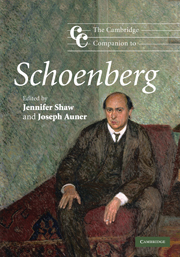Book contents
- Frontmatter
- 1 Introduction
- Part I Schoenberg's early years
- Part II Schoenberg, modernism, and modernity
- Part III Schoenberg between the World Wars
- Part IV Schoenberg's American years
- 15 Cadence after thirty-three years: Schoenberg's Second Chamber Symphony, Op. 38
- 16 Schoenberg's collaborations
- 17 Listening to Schoenberg's Piano Concerto
- 18 Schoenberg reception in America, 1933–51
- 19 Schoenberg: dead or alive? His reception among the postwar European avant-garde
- Notes
- Select bibliography
- Index
16 - Schoenberg's collaborations
from Part IV - Schoenberg's American years
Published online by Cambridge University Press: 28 September 2011
- Frontmatter
- 1 Introduction
- Part I Schoenberg's early years
- Part II Schoenberg, modernism, and modernity
- Part III Schoenberg between the World Wars
- Part IV Schoenberg's American years
- 15 Cadence after thirty-three years: Schoenberg's Second Chamber Symphony, Op. 38
- 16 Schoenberg's collaborations
- 17 Listening to Schoenberg's Piano Concerto
- 18 Schoenberg reception in America, 1933–51
- 19 Schoenberg: dead or alive? His reception among the postwar European avant-garde
- Notes
- Select bibliography
- Index
Summary
Collaboration, according to current English-language dictionaries, can mean to work in conjunction with others on literary, artistic, or scientific works: in 1940, however, it also became the label for a treacherous collusion with an enemy and, in particular, with the Nazis. Over the next sixty years the boundaries between these dual meanings – at once laudable and reprehensible; creative and destructive – became tangled and fused. For instance, our governments collaborate in bringing international criminals to justice as well as in occupying other nations' sovereign territory: in other words, “collaboration” is not a pure term. Yet even before 1940 the reality of artistic collaborations had become tainted and untenable for many, especially in Germany and Austria. Within a year of coming to power in January 1933, the National Socialists passed civil service laws that banned membership of the Reich Chamber of Culture to those who “did not possess the necessary reliability (Zuverlässigkeit) and aptitude (Eignung) for the practice of [their] activity.” When racial laws were passed soon after, and it became clear that at least 75 percent Aryan ancestry was an essential criterion for “reliability,” many artists – Aryans and Jews alike – attempted to distance themselves from their artistic collaborators who were now, by law, considered racially and artistically “alien,” and who therefore were also deemed to be unreliable and inept. The effect, as Schoenberg explained in a speech that he gave in 1935, little more than a year after leaving Berlin via Paris for a new life in America, was that Jews, “deprived of their racial self-confidence, doubted a Jew's creative capacity more than the Aryans did.”
- Type
- Chapter
- Information
- The Cambridge Companion to Schoenberg , pp. 226 - 237Publisher: Cambridge University PressPrint publication year: 2010



